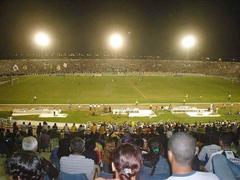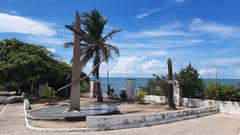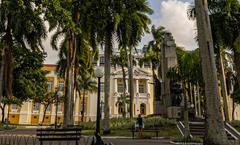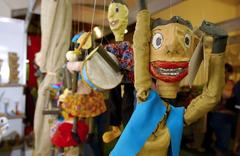Group Of Houses Of The Santa Casa De Misericórdia João Pessoa: Visiting Hours, Tickets, and Historical Significance
Date: 04/07/2025
Introduction
The Group of Houses of the Santa Casa de Misericórdia in João Pessoa is one of Brazil’s most significant colonial landmarks, representing centuries of philanthropy, faith, and social transformation. Rooted in a tradition that began in 15th-century Portugal, the Santa Casa has shaped the health, culture, and urban landscape of João Pessoa. This guide details its origins, architectural evolution, cultural impact, and provides practical information for visitors—including hours, admission, tours, and travel tips.
Table of Contents
- Introduction
- Historical Overview
- Architectural and Artistic Features
- Cultural and Social Impact
- Visitor Information
- Visiting the Igreja da Misericórdia
- FAQs
- Visuals and Media
- Related Resources and Further Reading
- Conclusion and Call to Action
- References
Historical Overview
Origins and Foundation
The Santa Casa de Misericórdia movement began in Lisbon in 1498, inspired by Queen Leonor and Franciscan ideals, and quickly spread to Portugal’s colonies (Santa Casa de Misericórdia - História). In Brazil, these charitable institutions became pillars of social welfare, with João Pessoa’s Santa Casa officially founded in 1912 (Santa Casa João Pessoa - História). Its mission was to provide medical care, shelter, and assistance to the city’s vulnerable populations, embodying the spirit of Christian charity and public service.
Architectural Development
The Santa Casa complex in João Pessoa comprises multiple interconnected buildings reflecting distinct eras. The oldest sections, like the Igreja da Misericórdia, date to the early 17th century and showcase early Baroque and Mannerist styles (Para Onde Ir; IPHAN). Later neoclassical expansions in the 20th century added hospital wings and support facilities (Patrimônio Histórico de João Pessoa). Preservation efforts have restored original facades and interiors, maintaining the site’s historical integrity.
Role in Public Health and Welfare
For decades, the Santa Casa was João Pessoa’s main provider of free or low-cost healthcare, especially before the advent of Brazil’s public health system (Santa Casa de Misericórdia - Funções; graduacao.afya.com.br). It also offered food, shelter, and burial services to the needy, playing a crucial role during epidemics like the Spanish flu.
Religious and Cultural Significance
The Santa Casa is closely tied to the Catholic Church, hosting chapels, religious processions, and annual celebrations that are integral to João Pessoa’s cultural calendar (Santa Casa e a Igreja Católica; Para Onde Ir). Its iconography and spiritual activities reinforce its identity as both a sacred and civic institution.
Preservation and Heritage
Recognized as a heritage site by local and federal authorities, including IPHAN, the Santa Casa’s conservation ensures its survival as a living monument (IPHAN). Restoration projects have focused on structural integrity, artistic details, and archival documentation (Recanto das Letras; UniSantos PDF).
Impact on João Pessoa’s Urban Landscape
Located in the historic center, the Santa Casa complex shaped the city’s urban development, attracting other institutions and providing green courtyards in the heart of the city (Turismo João Pessoa).
Notable Figures and Events
The institution’s history features prominent physicians, religious leaders, and philanthropists. Its archives preserve records of key milestones, health campaigns, and community outreach (Santa Casa João Pessoa - Acervo).
Contemporary Relevance
Today, the Santa Casa continues its charitable role, specializing in outpatient care, elderly services, and health education, often in partnership with universities and the public health system (Santa Casa João Pessoa - Serviços).
Architectural and Artistic Features
Colonial and Neoclassical Elements
The Igreja da Misericórdia exemplifies early colonial architecture: simple stone facades, minimal ornamentation, and a prominent position in João Pessoa’s original city grid (UniSantos PDF). Later expansions introduced neoclassical elements, with robust masonry and decorative details.
Interior Decoration and Artistic Heritage
Inside the church, visitors will find azulejos (Portuguese tiles), painted wooden ceilings, and religious artworks. The nave and chancel layouts, as well as the “roda dos expostos” (foundling wheel), highlight the institution’s dual role as a church and social shelter (Recanto das Letras; Wikipedia).
Regional Adaptations
The Santa Casa incorporates regional materials and artistic influences, resulting in a unique Northeastern Brazilian style. Recent restoration projects have preserved these local features (Recanto das Letras).
Cultural and Social Impact
Social Welfare Mission
The Santa Casa has been the backbone of João Pessoa’s social assistance for centuries, providing healthcare, shelter, and support for the city’s most vulnerable (saudesite.com.br).
Integration with the Community
Religious festivals, processions, and charitable events foster strong community ties and perpetuate the Santa Casa’s legacy of compassion (Para Onde Ir).
Educational and Cultural Outreach
The site hosts museums, exhibitions, and guided tours, engaging students, researchers, and tourists in João Pessoa’s philanthropic and artistic heritage (explorial.com).
Visitor Information
Visiting Hours and Admission
- Santa Casa Complex: Monday–Friday, 9:00 AM – 5:00 PM; Saturday, 9:00 AM – 1:00 PM; closed Sundays and public holidays.
- Igreja da Misericórdia: Monday–Saturday, 8:00 AM – 5:00 PM; closed Sundays and public holidays.
- Admission: Free; donations appreciated. Guided tours may require nominal fees or advance booking.
Guided Tours and Events
- Guided tours provide historical, architectural, and cultural context. Bookings can be made via the official Santa Casa website or João Pessoa’s tourism office.
- Special events occur during major Catholic holidays, notably Holy Week, with processions and religious ceremonies (Para Onde Ir).
Accessibility
- The site is partially accessible; ramps and accessible restrooms are available in the main complex, but historic features may restrict access in some areas. Contact staff in advance for assistance.
Location and Getting There
- Centrally located in João Pessoa’s historic core (Rua da Misericórdia), accessible by public transport, taxi, or on foot.
- Parking is available nearby.
Visitor Tips
- Wear comfortable shoes for exploring the complex.
- Dress modestly, especially during religious services.
- Visit early or late in the day for fewer crowds and cooler temperatures.
- Bring water and sun protection due to the tropical climate.
- Learn basic Portuguese phrases or use a translation app, as English is not widely spoken (Lonely Planet).
Facilities and Amenities
- Basic restrooms are available. No on-site cafés or shops, but options are plentiful nearby in the historic center.
Photography and Conduct
- Photography permitted in most areas, but avoid flash and tripods; respect religious services.
- Professional photography or filming requires prior authorization.
Visiting the Igreja da Misericórdia
Hours, Tickets, and Access
- Open Monday–Saturday, 8:00 AM – 5:00 PM.
- Free admission; donations welcome.
- Guided tours available with advance notice.
Guided Tours
- Local guides or tourism office can arrange tours, including access to areas not open to the general public (Para Onde Ir).
Special Events and Religious Ceremonies
- Major processions occur during Holy Week, attracting large crowds and sometimes affecting access.
Architectural Highlights
- Mannerist and Baroque features, limestone facades, and original 17th-century elements (IPHAN).
Accessibility and Safety
- Accessibility is limited in some areas; staff are available to assist.
- João Pessoa is relatively safe, but standard urban safety precautions apply (Lonely Planet).
Frequently Asked Questions (FAQ)
Q: What are the visiting hours?
A: Santa Casa: Monday–Friday, 9 AM–5 PM; Saturday, 9 AM–1 PM. Igreja da Misericórdia: Monday–Saturday, 8 AM–5 PM. Closed Sundays and public holidays.
Q: Is there an entrance fee?
A: Admission is free; donations are appreciated.
Q: Are guided tours available?
A: Yes, book in advance via official channels.
Q: Is the site accessible?
A: Partial accessibility; contact ahead for support.
Q: Can I take photographs?
A: Yes, without flash. Observe posted guidelines.
Visuals and Media
Explore high-resolution images and virtual tours on the official João Pessoa and Santa Casa websites. Digital archives offer further insights (UniSantos PDF).
Related Resources and Further Reading
- Santa Casa João Pessoa - História
- Para Onde Ir - Igreja da Misericórdia João Pessoa
- IPHAN - João Pessoa Igreja da Misericórdia
- Recanto das Letras - Artigos de Turismo
- UniSantos PDF - Patrimônio Histórico
- saudesite.com.br - A História da Santa Casa no Brasil
- explorial.com - Igreja da Misericórdia
- Santa Casa João Pessoa - Serviços
- Santa Casa e a Igreja Católica
Conclusion and Call to Action
The Santa Casa de Misericórdia in João Pessoa is more than a historical monument—it is a living center of charity, culture, and architectural beauty. Its legacy as a provider of healthcare and social welfare continues alongside its role as a spiritual and educational resource. Whether exploring its colonial church, attending a community event, or joining a guided tour, visitors will find both inspiration and insight into Brazil’s unique blend of history and compassion.
Plan your visit today! For up-to-date information, special events, and guided tours, download the Audiala app, follow us on social media, and browse our related articles to discover more about João Pessoa’s historic treasures.
References
- Santa Casa João Pessoa - História
- saudesite.com.br - A História da Santa Casa no Brasil
- Para Onde Ir - Igreja da Misericórdia João Pessoa
- IPHAN - João Pessoa Igreja da Misericórdia
- Santa Casa de Misericórdia - Funções
- graduacao.afya.com.br - Santa Casa de Misericórdia
- Recanto das Letras - Artigos de Turismo
- UniSantos PDF - Patrimônio Histórico
- explorial.com - Igreja da Misericórdia
- Santa Casa e a Igreja Católica



